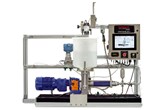Developing a retrievable remote open barrier plug
Published by Alfred Hamer,
Editorial Assistant
Oilfield Technology,
Geir Melhus, Vice President Operations, and Johannes Nesse, Field Service Manager, TCO, Norway, examine the process of developing a new type of shallow set barrier plug, and its implications for upstream technology.

A partner company challenged TCO to develop a new type of shallow set barrier plug that could be deployed on wireline, remotely opened and even retrieved after opening to retain a full wellbore. The resulting R&D project successfully solved the challenge. It also ushered in technological innovations that migrated successfully to TCO’s wider product portfolio.
The case was a drilling campaign for a large North Sea field development. Eight wells were planned for drilling, but the wells needed to be suspended for up to a year while waiting for the vertical Christmas trees (VXTs) to arrive. The operator needed to suspend the wells in a manner that was safe, cost effective and did not limit future operational options. The ability to optionally retrieve the entire plug after opening was regarded as additional benefit.
A new option
At that time, retrievable barrier plugs were not an option in the production portfolio for the company. For shallow barriers, they had relied on the first generation of the disappearing tubing hanger plug (DTHP) for years as a tried and tested barrier plug with remote open features and bypass capabilities. The first generation DTHP plugs were limited in design due to small ID through the assembly, which was not ideal for future well intervention operations. The restricted ID in combination with explosive opening made it challenging to use as primary solution.
Removing the entire plug hardware from the wellbore was a challenge the company were keen to solve. They saw retrievability as adding flexibility for operators. Well conditions and intervention requirements can change over time, and a full bore is necessary for future wireline and perforation operations.
With their partner company in the field development project they set up a two year R&D project to deliver on the operator’s request. The partner was a supplier of tubing hangers, and the new product needed to fit their proprietary locking profiles. The project was also used to deliver a major upgrade of the glass plug opening mechanism. Where they previously relied on an explosive shaped charge to shatter the laminated glass, there was a desire to move to a wholly mechanical solution.
This would turn out to be a major benefit to the product range and simplify logistics for all parties. As product was already being redesigned, it was also logical to improve the ID after opening from a restricted ID to a full ID. The new product being an iteration on the DTHP, it was decided to name it the DTHP-R, with R standing for Retrievable.
Testing for pressure
For this R&D project, use was made of the ISO 14310 V0 standard, which specified that plugs shall be able to withstand differential pressures of 11 000 psi and that no gases or liquids pass the barrier. This entails that new products must be extensively tested during development. A significant part of the R&D time was spent testing prototypes. This was done in testing facilities in Bergen, but there was also a full-scale test conducted at the Ullrigg Test Centre in Stavanger, owned and operated by NORCE – Norwegian Research Centre. The site offers high pressure and high temperature (HPHT) testing facilities and infrastructure that allowed qualification for the new DTHP-R to the highest industry standards.
The DTHP-R would be fitted with the E-Trigger solution, which is a programmable remote open device with flexible solutions for opening the glass barrier plug for production. A dedicated opening signature for the plug is coded into the E-Trigger in collaboration with the operator. When the unique key – in the form of a sequence of pressure cycles – is recorded by the device, the mechanism shatters the glass plug, removing the glass barrier completely.
Doing away with explosives
Designing a new locking profile was a new challenge for TCO. Ensuring failsafe operation triggered a lot of testing, involving both partners and other service vendors. The company progressed and solved the locking profile challenge due to good communication between all parties.
The E-trigger was a familiar product as this is also available as a separate module. The main challenge in adapting it to the DTHP-R was to fit the electronic components of the E-trigger inside the restricted space of the new unit. It was a tight squeeze, also because TCO was adding even more components in the form of new mechanical glass shattering mechanism.
The time had come to do away with the explosive charges. Not because they were unreliable, but mostly because the logistics connected to any equipment containing explosive charges drives costly paperwork, operational risk issues and import/export restrictions. Developing a non-explosive opening device would make the technology more accessible and easier to user for customers, regardless of where on the planet they are located.
The glass plug TCO pioneered in barrier plugs is made of high grade, laminated security glass, held in place by grooves machined into the plug casing sleeve and sealed tight. The inherent property of security glass is that it can withstand high differential pressure but will shatter when impacted sharply by an object. Just as car windshields or glass tables will. It was now imperative to design a fail-safe mechanical solution for plug opening.
To access the full version of this article and get a free trial subscription to Oilfield Technology, sign up here!
Read the article online at: https://www.oilfieldtechnology.com/special-reports/14052025/developing-a-retrievable-remote-open-barrier-plug/
You might also like
Chandler Engineering offers 6700-M mini flow loop system for friction pressure testing
This latest addition to the 6700 Friction Flow Loop product line delivers advanced testing capabilities in a portable, space-saving design.

